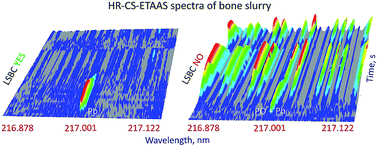Direct determination of lead in bones using slurry sampling and high-resolution continuum source electrothermal atomic absorption spectrometry†
Abstract
A straightforward, quick, sensitive and reliable method is introduced for the determination of lead in bones using slurry sampling and high-resolution continuum source electrothermal atomic absorption spectrometry (HR-CS-ETAAS). The spectral interference caused by the molecular absorption of PO molecules with rotational fine structure coinciding with the analyte absorption at the most sensitive resonance line 217.001 nm in time was identified and successfully corrected by applying a mathematical correction algorithm using the spectrum obtained by vaporization of hydroxyapatite. The slurry preparation and measuring conditions were determined by means of a response surface methodology. Experiments were designed according to a 27−4 replicate (n = 3) fractional factorial design for seven factors (particle size, glycerol and HNO3 concentration, sonication time, concentration of the chemical modifier, pyrolysis and atomization temperature) each at three different levels, including central points. The optimized conditions were 100 mg of a ground sample with particle size < 315 μm, dilution in a liquid-phase composed of 10% w/w glycerol and 5.0% w/w nitric acid solutions, a sonication time of 2 min and the final slurry volume of 10.0 mL. A detection limit of 9.1 μg kg−1 and characteristic mass of 7.6 pg were achieved using the suggested method under the optimized experimental conditions. Sufficient analyte stabilization was achieved by using 1 μg Pd and 50 μg citric acid. Accurate data were obtained with the use of matrix-free calibration. The accuracy of the method was established by analysing NIST SRM 1486 Bone Meal. Further, the results acquired for ten river otter samples by slurry sampling were compared with those determined after microwave-assisted digestion by inductively coupled plasma time of flight mass spectrometry (TOF-ICP-MS) to assess the accuracy of the method. The results obtained by the two methods were compared using a paired t-test (at the 95% confidence level) and showed no significant difference. The precision of the introduced method was better than 5.5%.



 Please wait while we load your content...
Please wait while we load your content...